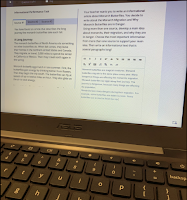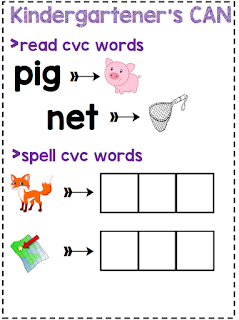SEYMOUR 6TH GRADE CENTER ASSISTANT PRINCIPAL A: 1000 S. Poplar St. Seymour P: 812.523.4637 |
Redding Instruction
Sunday, April 11, 2021
Friday, April 19, 2019
Kindergarten Cause and Effect
Cause and Effect In Kindergarten
 This week I had the opportunity to visit two of our kindergarten classrooms. Our focus was on cause and effect. We begin the lesson by defining cause and effect. Cause is "The reason something happened" and Effect is "What Happened." We also talked about how the cause can lead to different effects, they aren't going to be the same for every person!
This week I had the opportunity to visit two of our kindergarten classrooms. Our focus was on cause and effect. We begin the lesson by defining cause and effect. Cause is "The reason something happened" and Effect is "What Happened." We also talked about how the cause can lead to different effects, they aren't going to be the same for every person!
We then used Google Slides to talk about cause and effects. The students were given the cause and had to figure out effects (the effects were covered up and removed) that may take place! The slide show is attached if you want to use it in your classroom! Here is a few of the slides:
After we concluded the slideshow, together we listened to the book The Tale of Peter Rabbit. Students were prompted to listen as Peter makes many choices throughout the story and the effects that come after his choices. We listened through YouTube. The students then went back to their seats and we accessed Google Classroom which linked them to Google Slides. I "sniped" images from the YouTube video and gave them the cause on the left hand side of the slide. Students then had to figure out the effects.
Here are some pictures and videos from the Lesson:

Friday, April 12, 2019
Constructed Response Resources
Constructed Response
(used in 4th Grade Classes)
Over the past several weeks, we have used the Yes MA'AM format to continue our constructed response practice.
Our first article was off of Newsela: Are some "Fortnite" video gamers too young for it?" This article was put on Edulastic. We practiced the "hot text" feature that students will see on ILEARN and then moved on to the constructed response. For the constructed response I broke it down into 4 questions. For example, The first question asked the students to write the 1st sentence in a YES MA'AM by restating the question. The students moved through the rest of the YES MA'AM with similar directions. This allowed students to know exactly what we were looking for. I choose this method for this class because we still had several students wanting to write more than four sentences or were writing off topic or forgetting their sentence starter.
Here is an example of what the question looked like:
Link to Edulastic Assignment: Fortnite
 The second article we used was from the 4th grade Instant Station Genre Studies. Each grade level has a copy of this book! The book contains paired text with questions at the end. The title of this article was: A Long Journey. The article talked about the Monarch's migration from Canada to Mexico in the fall. Students read the article using Edulastic and then wrote a constructed response. This time students were not given as much support. They were still provided with the frame work but had to come up with sentence starters on their own!
The second article we used was from the 4th grade Instant Station Genre Studies. Each grade level has a copy of this book! The book contains paired text with questions at the end. The title of this article was: A Long Journey. The article talked about the Monarch's migration from Canada to Mexico in the fall. Students read the article using Edulastic and then wrote a constructed response. This time students were not given as much support. They were still provided with the frame work but had to come up with sentence starters on their own!
Here is what the question posed looked like:
Link to Edulastic Assignment: A Long Journey
Our third article was a fable pulled from the same resource as mentioned above. The title was: The Tale of Arachne. Again this resource provides questions and already has a constructed response question embedded. The students read the article on Edulastic and then typed their response. Students were provided with no support on the question, but still had resources hanging in the room to refer back to!
I loved the constructed response question:
Link to Edulastic Assignment: A Tale of Arachne
Monday, April 8, 2019
4th Grade Performance Task
4th Grade Performance Task
Over the past two weeks I had the opportunity to work with our 4th graders on the ILEARN performance task. I used Edulastic to create the performance task. The articles were pulled from Newsela and a Video was linked from YouTube to use as sources for the task.We completed the performance task over a two day period. We viewed the sources and answered the three questions leading up to the extended response on the first day. On the second day we tackled the extended response.
The questions were worded just as our students will see them on ILEARN. We want them to feel prepared and confident going into the test with the wording they will see.
Leading up to the extended response were two YES! MA'AM questions followed by a matching question (matching details to the sources they found them in).
On the 2nd day we tackled the extended response. Our task was to write an informational article. We used Smekens Table Top Organizer to help us in this process. Obviously we can't give our students this on test day, but we can teach them to draw their "tabletops" on their scratch paper.

Check out the Performance Task: 4th Grade Performance Task
Check out the Table Top PDF: Smekens Table Top Writing Organizer
I revised the original to fit 5 on a front/back copy:
Mrs. Stahl's Table Top PDF
Friday, March 15, 2019
1st Grade Plot
1st Grade Plot
 Over the past week, I had the opportunity to visit our first grade classrooms. Our lesson focus was on story plot. We began the lesson by talking about what Plot is. We defined plot as "the important events that make up a story." Before reading, "My Lucky Day" by Keiko Kasza, I introduced the template students would be using to record on during the lesson. The Characters and Setting are story elements that play an important role in the story, but separating them from the plot--beginning, middle, and end--helped our 1st grade students really focus on the plot of the story. After looking at character and setting, we turned our focus towards the plot. I asked the students the first thing they noticed about the boxes for beginning, middle, and end. Of course they said the middle box was a lot bigger. I asked them "why?" and they knew that a lot more events happen in the middle of a story, then at the beginning and end.
Over the past week, I had the opportunity to visit our first grade classrooms. Our lesson focus was on story plot. We began the lesson by talking about what Plot is. We defined plot as "the important events that make up a story." Before reading, "My Lucky Day" by Keiko Kasza, I introduced the template students would be using to record on during the lesson. The Characters and Setting are story elements that play an important role in the story, but separating them from the plot--beginning, middle, and end--helped our 1st grade students really focus on the plot of the story. After looking at character and setting, we turned our focus towards the plot. I asked the students the first thing they noticed about the boxes for beginning, middle, and end. Of course they said the middle box was a lot bigger. I asked them "why?" and they knew that a lot more events happen in the middle of a story, then at the beginning and end.After reading, "My Lucky Day" we filled in the template together. See pictures from the lesson below:
Students then transitioned back to their Chromebooks and pulled up Google Classroom. On Google Classroom, they accessed you tube to listen to the story, "Don't Let the Pigeon Drive the Bus." After listening, students pulled up Google Slides, with the template broken down into different slides. We worked through this together! They practiced dragging and dropping and typing sentences. The students loved using the Chromebooks to complete the task. I was impressed how well our 1st graders are typing.
I love using Google Slides for lessons. However, there is an extra step to turning it in (there is no turn in button on the top right). Students navigate back to Google Classroom and hit the blue "Turn In" button."
Here are some of the screens of students from this weeks lessons:
Blank Plot Template
Blank Google Slide Template
Kindergarten CVC Words
Kindergarten CVC Words
This week I had the opportunity to visit our Kindergarten classrooms and do a lesson on reading and writing CVC words. To begin the lesson I defined our focus: Kindergartners can read CVC words and Kindergartners can spell CVC words. We used the anchor chart to the right to begin our lesson. I had students repeat the learning focus as we moved to the different sections on the anchor chart. I also covered up the pig and the net so that our focus was on blending sounds and getting our mouths ready to say the sounds in the word.
We then used Google Classroom to link to Google Slides for the students task. The students were asked to read cvc words and drag and drop pictures that matched the cvc word. The second part of the task on Google Slides was for the students to build cvc words. Students were given the letters and then asked to drag and drop them into the correct boxes.
Here are some pictures from the lesson:

This is pictures of how the Google Slide Activity looked:
CVC Anchor Chart
CVC Google Slide Activity
Friday, March 8, 2019
4th Grade Main Idea Versus Theme
4th Grade--Main Idea Versus Theme and Constructed Response Using Google Classroom
This week I had the opportunity to visit our fourth grade classrooms and model a lesson on Main Idea versus Theme and Construed Response using Edulastic.
The main idea lesson started off with using an anchor chart. It allowed us to look at the differences between main idea and theme. It also pointed out how our readers can determine the difference between the two.
We used the passage "A Tricky Monkey" to pull Theme and Main Idea from. Using Edulastic allowed for students to practice the drag and drop feature and hot text feature they will see on ILEARN.
The other lesson I did in 4th grade this week focused on using Edulastic to write a constructed response after reading an article. I pulled the article: Issue Overview: Should we have Zoos? from Newsela and copied it right into Edulastic. You can do the same with all the questions and answers.
Issue Overview: Zoos Edulastic (Qs and CR)
Issue Overview: Zoos Edulastic (Only Constructed Response)
Theme Versus Main Idea: Edulastic
Issue Overview: Zoos Edulastic (Qs and CR)
Issue Overview: Zoos Edulastic (Only Constructed Response)
Theme Versus Main Idea: Edulastic
Subscribe to:
Comments (Atom)

















